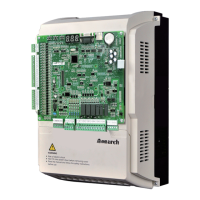6 Parameter Description
-
228
-
Function
Code
Name Setting Range Default Unit Property
F8-03 Drive gain 0.00 to 2.00 0.60 -
★
F8-04 Brake gain 0.00 to 2.00 0.60 -
★
These two parameters are used to set the pre-torque gain when the elevator runs on
the drive side or the brake side.
For details, see 5.6 Riding Comfort Adjustment.
Function
Code
Name Setting Range Default Unit Property
F8-05 Current car load 0 to 255 0 -
the NICE3000
new
by using a load cell to judge overload or full-load, or calculate the
torque current for load cell pre-torque compensation.
Function
Code
Name Setting Range Default Unit Property
F8-06 Car no-load load 0 to 255 0 -
★
F8-07 Car full-load load 0 to 255 0 -
★
F8-06 and F8-07 respectively records the car no-load and full-load conditions in the
car. They are AD sampling values.
Function
Code
Name Setting Range Default Unit Property
F8-08
Anti-nuisance
function
0: Anti-nuisance function disabled
1: Nuisance judged by load cell
2: Nuisance judged by light curtain
4: Nuisance judged by light-load
signal
0 -
☆
It is the criteria for judging whether nuisance exists. The values are as follows:
■
0: Anti-nuisance function disabled
■
1: Nuisance judged by load cell
A load cell is required. The system judges whether nuisance exists by comparing the
load cell data and the number of car calls.
■
2: Nuisance judged by light curtain
The system determines that nuisance exists when the light curtain does not act
after the elevator stops at arrival for three consecutive times.
■
4: Nuisance judged by light-load signal
If the light-load signal is active, the system determines that nuisance exists when
the number of car calls is greater than a certain value.
■
When the system determines that the elevator is in the nuisance state, it cancels all
car calls. In this case, call calls need to be registered again.

